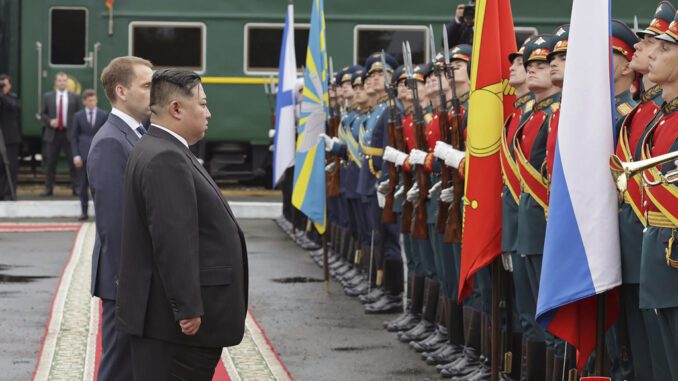
SEOUL, South Korea — North Korean leader Kim Jong Un ended a six-day trip to Russia that triggered global concerns about weapons transfer deals between the two countries locked in separate standoffs with the West, news outlets reported.
Kim’s armored train departed to the sound of the Russian patriotic march song “Farewell of Slavianka” at the end of a farewell ceremony at a railway station in Artyom, a far eastern Russian city about 124 miles from the border with North Korea, Russia’s state news agency RIA reported.
Senior officials including Russia’s Minister of Natural Resources Alexander Kozlov and Primorye regional Gov. Oleg Kozhemyako were present at the ceremony, which featured a Russian military band playing both North Korean and Russian national anthems.
It was Kim’s longest foreign travel since he took power in late 2011. Observers said Kim returned to Pyongyang, the North Korean capital, Monday afternoon.
Entering Russia last Tuesday in his first overseas trip in more than four years, Kim met President Vladimir Putin and visited key military and technology sites, underscoring the countries’ deepening defense cooperation in the face of separate, intensifying confrontations with the U.S. and its allies. Foreign officials and experts have said North Korea could provide badly needed munitions for Moscow’s war on Ukraine in exchange for sophisticated Russian weapons technology that would advance Kim’s nuclear ambitions.
North Korea may have tens of millions of aging artillery shells and rockets based on Soviet designs that could bolster Russian forces in Ukraine, analysts say, even though its old artillery systems have a reputation for poor accuracy. Both sides have been reportedly firing thousands of artillery rounds a day.
U.N. Security Council resolutions — which Russia, a permanent member, previously endorsed — ban North Korea from exporting or importing any arms. Observers say Russia’s alleged attempts to receive ammunition and artillery shells from North Korea suggest Moscow’s desperation to refill its arsenal exhausted in the war with Ukraine.
“Military cooperation between North Korea and Russia is illegal and unjust as it contravenes U.N. Security Council resolutions and various other international sanctions,” South Korean President Yoon Suk Yeol said in written responses Sunday to questions from The Associated Press. “The international community will unite more tightly in response to such a move.”
In return for supplying conventional arms to Russia, experts say North Korea would seek Russian economic and food aid but also transfers of technologies to build powerful missiles, a nuclear-propelled submarine and a spy satellite. North Korea has publicly sought to introduce such high-tech weapons systems citing what it called intensifying U.S.-led hostilities.
Earlier Sunday, Kim was in a lighter mode, touring a university and watching a walrus show at a Russian aquarium. Russia’s state media released videos of Kim, accompanied by his top officials, talking with Russian officials through translators at the campus of the Far Eastern Federal University in Russky Island.
On Saturday, Kim traveled to an airport near Vladivostok, where Defense Minister Sergei Shoigu and other senior military officials gave him an up-close look at Russia’s strategic bombers and other warplanes. Kim and Shoigu later in the day went to Vladivostok, where they inspected the Admiral Shaposhnikov frigate.
On Friday, Kim visited an aircraft plant in the city of Komsomolsk-on-Amur that produces Russia’s most powerful fighter jets.
The Russian warplanes shown to Kim on Saturday were among the types that have seen action in Ukraine, including the Tu-160, Tu-95 and Tu-22 bombers that have regularly launched cruise missiles. During Kim’s visit, Shoigu and Lt. Gen. Sergei Kobylash, the commander of the Russian long-range bomber force, confirmed for the first time that the Tu-160 had recently received new cruise missiles with a range of more than 4,040 miles.
Shoigu, who had met Kim during a rare visit to North Korea in July, also showed Kim another of Russia’s latest missiles, the hypersonic Kinzhal, carried by the MiG-31 fighter jet, that saw its first combat during the war in Ukraine.
Kim’s summit with Putin was held at Russia’s main space launch site, a location that pointed to his desire for Russian assistance in his efforts to acquire space-based reconnaissance assets and missile technologies. In recent months, two North Korean launches to send a spy satellite into space ended in failure, and the North vowed to conduct a third attempt in October.
During the meeting with Putin, Kim said his country would offer its “full and unconditional support” for Russia’s fight to defend its security interests, in an apparent reference to the war in Ukraine. Kim invited Putin to visit North Korea at “a convenient time,” and Putin accepted.
It was Kim’s second summit meeting with Putin. The previous meeting took place in Vladivostok in April 2019, two months after Kim’s high-stakes nuclear diplomacy with then-U.S. President Donald Trump fell apart during their second summit in Vietnam.


